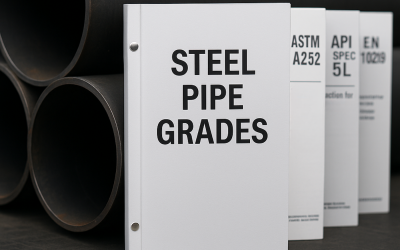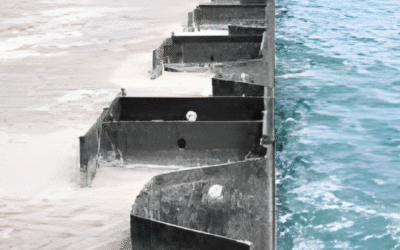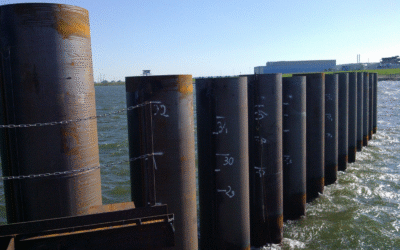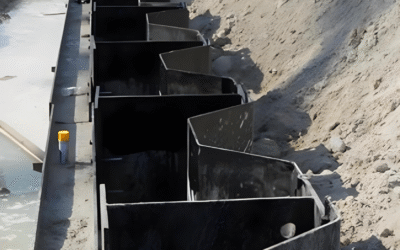Introduction: Why Steel Tie Rods Matter in Critical Structures
In civil and marine engineering, steel tie rods play a critical role in stabilising retaining structures, anchored quay walls, and sheet pile systems. Understanding Steel Tie Rods Function is essential for engineers and contractors who design structures that must safely resist lateral earth and water pressures. When properly designed and installed, a marine tie rod system can extend the service life of harbours, ports, bridge abutments, and waterfront structures for decades.

What is a Steel Tie Rod?
A steel tie rod is a structural tension steel bar that connects a wall or sheet pile to a stable anchor point — such as a concrete deadman or anchor block — to resist outward forces. Its primary function is to transfer tensile loads efficiently and maintain the integrity of retaining structures.
- Materials Used: High-strength steel grades like 355, 460, 500, and 700 are standard choices for tie rods due to their strength, ductility, and durability in harsh environments.
- Design Standards: Engineering design and fabrication should follow recognised guidelines such as EN 1993-5: Eurocode for Steel Piling and EN 1993-1-11: Design of Structures with Tension Components.
- System Components: A complete marine tie rod system typically includes the threaded rod, couplers, wall plates, nuts, washers, and corrosion protection systems. In some designs, anchor bolts may also be used to fix wall plates or brackets to concrete anchor blocks.

Steel Tie Rods Function Explained
The Steel Tie Rods Function can be summarised in three primary structural roles:
- Load Transfer: Steel tie rods carry tensile loads generated by lateral earth pressure, hydrostatic forces, and external loads like berthing impacts in port structures. They transfer these forces to a stable anchor point, preventing excessive bending moments in the wall.
- Resisting Lateral Earth and Water Pressure: For marine applications, such as quay walls or bulkheads, a marine tie rod is critical for stabilising sheet piles that retain soil and water. Without tie rods, anchored sheet pile walls could rotate or slide outward under lateral pressure, risking structural failure.
- Connecting Structural Elements: Steel tie rods connect sheet pile walls, retaining walls, or cofferdams with anchor blocks or deadman anchors buried in stable soil. This connection transforms individual elements into an integrated system capable of withstanding significant external forces.

Applications of Steel Tie Rods in Civil and Marine Engineering
Steel tie rods and marine tie rods are vital across various sectors:
- Ports and Harbours: Anchored quay walls, bulkheads, and jetty structures depend on marine tie rods to handle berthing loads and wave action.
- Retaining Walls: Used in urban excavation, basement walls, bridge abutments, and waterfront stabilisation.
- Flood Protection: Riverbanks, levees, and cofferdams often incorporate tie rod systems to reinforce sheet pile walls.
- Bridge Structures: Certain arch bridges and suspension systems use tie rods to balance tensile forces.
Case Example: Marine Tie Rod in a Sheet Pile Anchor Wall
Consider a typical marine tie rod application in a quay wall. A steel sheet pile wall retains backfill soil and resists tidal forces. The steel tie rods are anchored into buried concrete deadman blocks, forming a stable, continuous system. Engineers calculate the required tensile capacity, length, spacing, and corrosion protection to ensure the system performs reliably in aggressive saltwater conditions.

Key Considerations for Long-Term Performance
- Corrosion Protection: Marine tie rods are exposed to seawater and aggressive soils. Protective measures such as hot-dip galvanising, epoxy coatings, or cathodic protection significantly extend the lifespan of the system.
- Tensioning: Correct tensioning during installation is critical. Uneven or inadequate tensioning can lead to wall deflection, overstressing, or premature failure.
- Inspection and Maintenance: Regular inspections help detect signs of corrosion, fatigue, or loss of tension. This is especially important for marine structures exposed to dynamic loading and harsh environments.

Conclusion
A clear understanding of Steel Tie Rods Function is fundamental for any project involving anchored retaining structures. When designed to international standards, correctly tensioned, and protected against corrosion, a marine tie rod system can provide decades of reliable service and stability in some of the world’s harshest conditions.
If you would like to discuss how we can help design or supply custom steel tie rod systems for your next project, get in touch with our engineering team today. We are always happy to consult with our clients and find the most practical, economic solution to meet your specific requirements.
Related Products from Aema Steel
- Steel Tie Rod Systems
- Hot Rolled U Type Sheet Piles
- Hot Rolled Z Type Sheet Piles
- Steel Pipe Piles
- Welded H Piles
Contact us today to receive a tailored offer for your upcoming project.







